Endangered freshwater and terrestrial molluscs of Santa Catarina State, Southern Brazil: check list and evaluation of the regional threats that they suffer ! ...
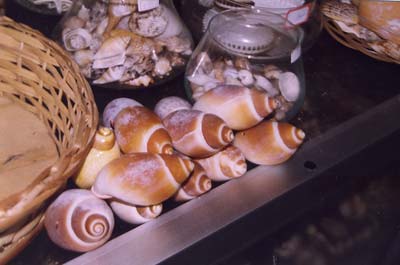
ENDANGERED FRESHWATER AND TERRESTRIAL MOLLUSCS OF SANTA CATARINA STATE, SOUTHERN BRAZIL: CHECK LIST AND EVALUATION OF THE REGIONAL TREATS THAT THEY SUFFER

A. IGNACIO AGUDO-PADRÓN
Project “Avulsos Malacológicos”, Caixa Postal (P.O. Box) 010, 88010-970, Centro, Florianópolis, Santa Catarina, SC, Brasil
In spite of galloping scientific and technological progress, and in similar form to the that happens in other places of our Neotropical country and planet in general, we still today have a lot of difficulty in evaluating the threats that suffer the continental - terrestrial and freshwater - molluscs species in the geo-political territory of Santa Catarina's State, SC, the smallest space portion of the Southern Brazil mosaic (Agudo & Bleicker 2006 a; Agudo-Padrón 2006; Agudo 2007 a; Agudo-Padrón 2007, 2008 b & d, 2009 a-b; Agudo-Padrón & Bleicker 2009), among other reasons for the lack of solid population data and the small amount of resident specialists in this state, practically us acting alone - systematically to 14 complete years - at regional level in the subject (Agudo-Padrón 2010 a-b, 2011 a-b).
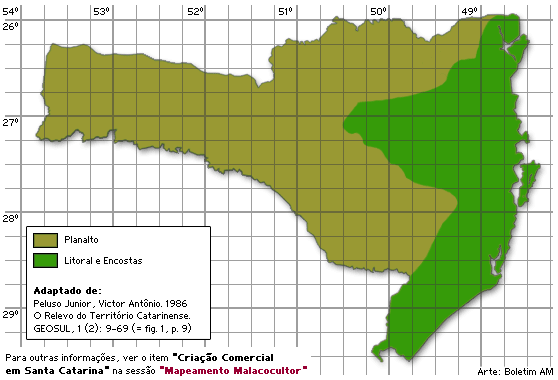
Geological Relief
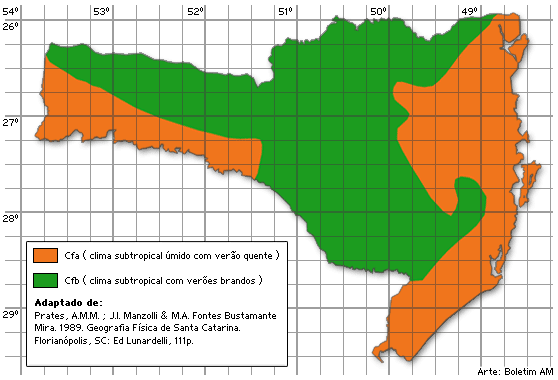
Climatic Types
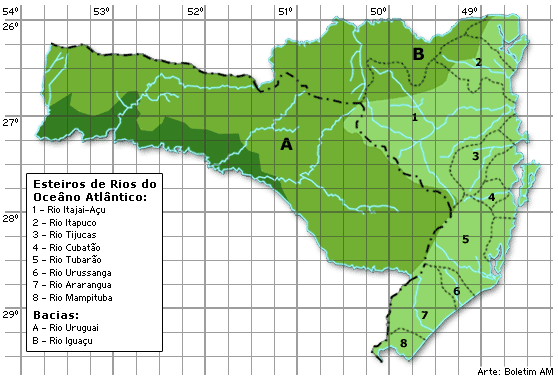
Hydrography
Nowadays, the Santa Catarina State administers in his territory[1] nine State Ecological Units of Conservation - six of the category “Park” (Agudo-Padrón & Bleicker 2009 a), that is more flexible as for the uses of the area and where the access to the public is established but allowed, and three of the category “Reserve”, where the environmental handling is quite restricted and the access only allowed to researchers, besides four “National Ecological Parks”.
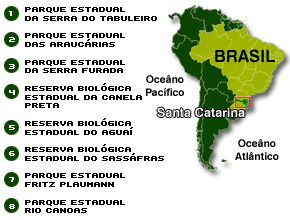
Ecological Parks and Environmental Reserves
However, do they truly result effective in practice how much the conservation of our known continental malacological species (Agudo-Padrón 2009 a, Agudo-Padrón & Bleicker 2009 b) and of those still no registered ? … Even so, today its sensitive bio-ecological ignorance in this territory is mixed to the fact of the urgent need of its effective conservation (Agudo-Padrón 2009 c: 7).
As previously noticed by specialists (Moraes 2006), all of the Brazilian native molluscs species are in serious extinction threat, besides forms that nor we got to know, or the that urgent the need of the inventoried and general study the same ones, as first step to seek her conservation. Considering the quick antropic environmental degradation, surely several species have became extinct before they have at least been known (Simone 2006: 3).
Besides the environmental degradation (including deforestation for agricultural ends and/or of forest exploration, mining, pollution of the river basins with dejections and several pollutant, indiscriminate application of agricultural poisons and chemical fertilizers, proliferation of the construction of hydroelectric mills, invasions of natural spaces for town plannings enterprises), the Brazilian species face a disloyal competition with invading forms, that are also responsible for serious sanitary and agronomic problems, among others (Agudo 2007 b; Agudo & Bleicker 2006 b; Agudo-Padrón 2006, 2007 a-b, 2008 a, c & e; Agudo-Padrón & Lenhard 2010; Agudo-Padrón 2010 a, 2011 a). Brought for creation or even accidentally, those exotic species are strange to the local ecosystem and for that they don't possess natural predators, what provides an uncontrolled growth of the population, that, consequently, it extinguishes the native species and starting to occupy their niches (Simone 2002).
That picture is worsened by the absence of a conscience of preservation of those animals, that difficultly represent in the lists of threatened animals published by ecological entities, considering although nobody preserves a natural area because there she has a snail – the mollusks have a very smaller appeal with the population than flashy vertebrate species, in spite of being fundamental for the ecological balance (Moraes 2006).
Personally we saw attending with having felt concern, in field, the decrease and until the disappearance of certain species in places and specific areas of the State, for instance the native giant snail Megalobulimus gummatus (Hidalgo, 1870) in the valley of the Uruguay river basin. Abundant in other times in the place, today it results difficult to find specimens in the local environment, evident consequence of the increase of the regional agricultural activities (application of pesticides, mainly), meanwhile that invading exotic species, such as the slug Pallifera sp", proliferate and they take care of the spaces (Agudo-Padrón 2011 a-b).
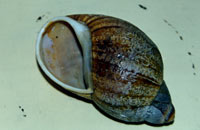
In other cases (very rares), native species resist and they adapt the anthropological conditions imposed in his natural environment when this invaded (Agudo 2007 b), getting to turn agricultural pests in small vegetable cultures, being combatted in consequence. Example of this situation is the giant native snail Megalobulimus oblongus (Müller, 1774) in sandbanks of the “Enseada do Brito”, Palhoça Municipal District of the Great Florianópolis, a traditional village of artisanal fishermen located in the proximities of the "Serra do Tabuleiro Ecological State Park" (Agudo-Padrón & Bleicker 2009 a).
Curious situation comes with the involvement of the giant freshwater native bivalve Anodontites trapesialis (Lamarck, 1819) in the Northern region of the State (Joinville Municipal District) and other Brazilian localities out of the State, whose parasitic larvae type “Lasidium” it arrives if it turns undesirable and harmful pest in enterprises fish farmers (Agudo 2005, 2008).
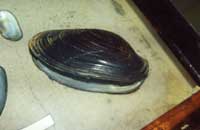
According to MANSUR et al (2003) and MANSUR (2008), it just is not enough to place the native species in lists of those threatened of extinction: it is necessary to know our native fauna from the taxonomic, morphologic and ecological point of view for then to propose handling strategies.
As previously commented on, bad administration and to the men's growing need for water are taking ecosystems of freshwater to the collapse, turning the freshwater species the threatened of the planet. Dams, irrigation and climatic changes that you disturb the cycle of rains are harming said habitats.
The molluscs that live in rivers and lakes are the threatened of the Earth, due to the collapse of this ecosystems. The taxes of extinction of species in freshwater environments are from four to six higher times than in marine or terrestrial habitats. Endemic species, such as the small aquatic snail Potamolithus catharinae Pilsbry, 1911, representative of the family HYDROBIIDAE (Silva & Veitenheimer-Mendes 2004), and the tiny freshwater limpets Burnupia ingae Lanzer, 1991 & Ferrissia gentilis Lanzer, 1991 (family ANCYLIDAE), they result particularly vulnerables case his fragile natural habitats comes to be altered by any type of human action (Agudo-Padrón 2011 a-b).
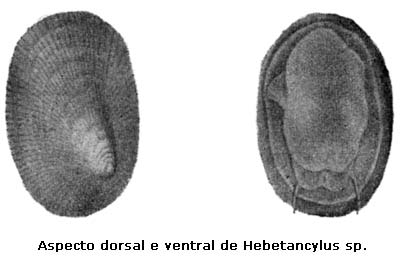
Hebetancylus sp, other representative brazilian little freshwater limpet
Fonte:
THOMÉ & LEMA (1973: 79)
The freshwater bivalve mollusks are particularly sensitive to the trampling, to the organic and chemical pollution, and other degradation types of the environment (Agudo-Padrón 2010 a, 2011 a-b). They present growth relatively slow and they don't usually occupy environments again previously disturbed. Endemic species exist for each basin and many of these with quite limited and terribly threatened areas of extinction due to the countless environmental alterations provoked recently by the human occupation.
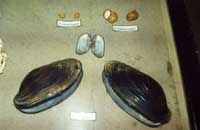
Now for Santa Catarina - SC, a total of 16 (9,0%) of its continental species like this registered – 184 species and confirmed subespecies (for a revision see: Agudo-Padrón 2008 f, 2009 a, 2010 a; Agudo-Padrón & Bleicker 2011), included in 10 Genera and 7 Families – one aquatic Prosobranchia / Caenogastropoda (Ampullariidae) & six Pulmonata terrestrial gastropods (one Ellobiidae, three Megalobulimidae and two micro-snails – Charopidae & Streptaxidae) and 10 Unionoid naiads (seven Mycetopodidae and three Hyriidae), they are considered in world categories established by the International Union for Conservation of the Nature – IUCN: seven as "Vulnerable", six "In Danger" and six “Without Category Established” (for other informations, see: Agudo-Padrón 2009 c: 7; MMA 2008 – for Brazil in general).
SYSTEMATIC SPECIES LIST
Class GASTROPODA
(7 species, 5 genera & families)
SubClass PROSOBRANCHIA / CAENOGASTROPODA
Family AMPULLARIIDAE
(1 species)
Pomacea sordida Swainson, 1823
Category IUCN: Without category established*
*Incorporate through the “Lista das Espécies da Fauna Ameaçadas de Extinção no Estado do Rio de Janeiro - RJ” – Species list of the fauna threatened of extinction in the State of Rio de Janeiro – RJ (1998), regional category “In Danger”, according to “Universidade do Estado do Rio de Janeiro - UERJ” …
SubClass PULMONATA
Family ELLOBIIDAE
(1 species)
Melampus coffeus (Linnaeus, 1758)
Category IUCN: Without category established*
*Incorporate through the “Lista das Espécies da Fauna Ameaçadas de Extinção no Estado do Rio de Janeiro - RJ” – Species list of the fauna threatened of extinction in the State of Rio de Janeiro – RJ (1998), regional category “Vulnerable”, according to “Universidade do Estado do Rio de Janeiro - UERJ”. Species considered a "marine form with wide ecological occurrence” …
Family MEGALOBULIMIDAE
(3 species)
Megalobulimus grandis (Martens, 1885)
Category IUCN: In Danger
Megalobulimus proclivis (Martens, 1888)
Category IUCN: In Danger
Megalobulimus oblongus (Müller, 1774)
Category IUCN: Without category established*
*Recently incorporate through the “Lista de Espécies da Flora e da Fauna Ameaçadas no Estado do Pará - PA” – Species List of the Flora and Fauna Threatened in the State of Pará - PA, regional category “In Danger” (Museu Paraense Emílio Goeldi), according to “SEMA – Secretaria de Estado de Meio Ambiente, Resolução 054/2007, 24/10/2007, Belém/Pará” …
Family CHAROPIDAE
(1 species)
Rotadiscus schuppi (Suter, 1900)
Category IUCN: In Danger*
*Concerning the micro-snail species Rotadiscus schuppi (Suter, 1900) (CHAROPIDAE), MANSUR et al (2003: 69- 70) they still consider with vindicative that dictates species it presents "Insufficient Data" (Agudo-Padrón 2009 c: 7) …
Family STREPTAXIDAE
(1 species)
Rectartemon depressus (Heynemann, 1868)
Category IUCN: Without category established*
*Recently incorporate through the “Livro Vermelho da Fauna Brasileira Ameaçada de Extinção” – Red Book of the Threatened of Extinction Brazilian Fauna, even so without category established UICN (Agudo-Padrón 2009 c: 8) …
Class BIVALVIA
(12 species, 5 genera and 2 families)
Order UNIONOIDA
Family MYCETOPODIDAE
(8 species & 3 genera)
Anodontites elongatus (Swainson, 1823)
Category IUCN: Without category established*
*Recently incorporate through the “Livro Vermelho da Fauna Brasileira Ameaçada de Extinção” – Red Book of the Threatened of Extinction Brazilian Fauna, even so without category established UICN (Agudo-Padrón 2009 c: 8) …
Anodontites ferrarisi (d’Orbigny, 1835)
Category IUCN: In Danger
Anodontites patagonicus (Lamarck, 1819)
Category IUCN: In Danger
Anodontites tenebricosus (Lea, 1834)
Category IUCN: Vulnerable
Anodontites trapesialis (Lamarck, 1819)
Category IUCN: Vulnerable
Leila blainvilleana (Lea, 1835)
Category IUCN: In Danger
Mycetopoda legumen (Martens, 1888)
Category IUCN: Vulnerable
Mycetopoda siliquosa (Spix, 1827)
Category IUCN: Vulnerable
Family HYRIIDAE
(4 species & 2 genera)
Diplodon expansus (Küster, 1856)
Category IUCN: Vulnerable
Diplodon multistriatus (Lea, 1834)
Category IUCN: Vulnerable
Diplodon rhuacoicus (d’Orbigny, 1835)
Category IUCN: Without category established*
*Recently incorporate through the “Livro Vermelho da Fauna Brasileira Ameaçada de Extinção” – Red Book of the Threatened of Extinction Brazilian Fauna, even so without category established UICN (Agudo-Padrón 2009 c: 8) …
Rhipidodonta charruana (d’Orbigny, 1835)*
Category IUCN: Vulnerable
*Referred in the Brazilian lists (MMA 2004, Agudo-Padrón 2009 c) under the taxonomic synonymy Diplodon martensi (Ihering, 1893) – see SIMONE (2006: 267) …
For more complete and detailed information (geographical distribution and mapping) concerning the species recognized to date in the territory of the State, please contact the author of this contribution.
REFERENCES:
AGUDO, I. 2005. Praga de bivalves límnicos em açudes. São Paulo, SP: Conquiliologistas do Brasil - CdB. Available online at: https://www.conchasbrasil.org.br/materias/pragas/limnicos.asp
AGUDO, A.I. 2007 a. Continental land and freshwater molluscs in Santa Catarina State, Southern Brasil: a general review of current knowledge. IUCN/SSC Internet Newsletter TENTACLE, (15): 11-14. Available online at: https://www.hawaii.edu/cowielab/tentacle/tentacle_15.pdf
AGUDO, I. 2007 b. Moluscos na condição de pragas no Brasil. São Paulo, SP: Conquiliologistas do Brasil - CdB. Available online at: https://www.conchasbrasil.org.br/materias/pragas/visaogeral/default.asp
AGUDO, I. 2008. Manejo e controle de pragas de bivalves “náiade” em açudes e viveiros piscicultores. São Paulo, SP: Conquiliologistas do Brasil - CdB. Available online at: https://www.conchasbrasil.org.br/materias/pragas/manejoecontrole/default.asp
AGUDO, A. I. & BLEICKER, M. S. 2006 a. First general inventory of the malacological fauna of Santa Catarina State, Southern Brasil. IUCN/SSC Internet Newsletter TENTACLE, (14): 8-10. Available online at: https://www.hawaii.edu/cowielab/tentacle/tentacle_14.pdf
AGUDO, A. I. & BLEICKER, M. S. 2006 b. Moluscos exóticos no Estado de Santa Catarina. Informativo SBMa, Rio de Janeiro, 37(157): 6-8.
AGUDO-PADRÓN, A. I. 2006. Intermediate host mollusks (Gastropoda: Pulmonata) of parasitic diseases in Santa Catarina´s State, Southern Brazil, with inclusion of new records to add to regional inventory. FMCS Newsletter ELLIPSARIA, 8(2): 11-13. Available online at: https://www.musselconservation.org/EVENTS/ELLIPSARIA/Ellipsaria2006_82.pdf
AGUDO-PADRÓN, A. I. 2007 a. Moluscos e saúde pública no Estado de Santa Catarina. Informativo SBMa, Rio de Janeiro, 38(161): 4-6.
AGUDO-PADRÓN, A. I. 2007 b. Diagnóstico sobre a potencial ocorrência do mexilhão-dourado asiático, Limnoperna fortunei (Dunker, 1857), no Estado de Santa Catarina, Brasil. Informativo SBMa, Rio de Janeiro, 38(162): 4-5.
AGUDO-PADRÓN, A. I. 2008 a. Vulnerabilidade da rede hidrográfica do Estado de Santa Catarina, SC, ante o avanço invasor do mexilhão-dourado, Limnoperna fortunei (Dunker, 1857). Revista Discente Expressões Geográficas, Florianópolis, 4(4): 75-103. Available online at: https://www.geograficas.cfh.ufsc.br/arquivo/ed04/artigo04.pdf
AGUDO-PADRÓN, A. I. 2008 b. Levantamento biogeográfico de moluscos no Estado de Santa Catarina, SC, região Sul do Brasil, Vertente Atlântica do Cone Meridional da América do Sul. Caminhos de Geografia, Uberlândia, 9(28): 126-133. Available online at: https://www.caminhosdegeografia.ig.ufu.br/viewarticle.php?id=664&layout=abstract
AGUDO-PADRÓN, A. I. 2008 c. Occurrence of the invasive exotic freshwater snail Melanoides tuberculatus (Müller, 1774) in Santa Catarina State, Southern Brazil, and the potential implications for the local public health. FMCS Newsletter ELLIPSARIA, 10(1): 16-17. Available online at: https://www.musselconservation.org/EVENTS/ELLIPSARIA/Ellipsaria2008_101.pdf
AGUDO-PADRÓN, A. I. 2008 d. First registration of continental mollusks in the Extreme West region of Santa Catarina's State, SC, Southern Brazil. FMCS Newsletter ELLIPSARIA, 10(2): 10-11. Available online at: https://www.musselconservation.org/EVENTS/ELLIPSARIA/Ellipsaria2008_102.pdf
AGUDO-PADRÓN, A. I. 2008 e. Ocorrência confirmada da semi-lesma exótica européia Milax valentianus Férussac, 1821 na região Sul do Brasil. Informativo SBMa, Rio de Janeiro, 39(166): 3.
AGUDO-PADRÓN, A.I. 2008 f. Listagem sistemática dos moluscos continentais ocorrentes no Estado de Santa Catarina, Brasil. Comunicaciones de la Sociedad Malacológica del Uruguay, Montevideo, 9(91): 147-179. Available online at: https://redalyc.uaemex.mx/redalyc/pdf/524/52412049003.pdf
AGUDO-PADRÓN, A. I. 2009 a. Recent terrestrial and freshwater molluscs of Santa Catarina State, SC, Southern Brazil region: a comprehensive synthesis and check list. VISAYA, April 20 2009: 1-12. Available online at: https://www.conchology.be/?t=41
AGUDO-PADRON, A. I. 2009 b. Recent continental malacological researches and inventory in the Southern Brazil and the general "Atlantic Slope of the South Cone", South America: a comparative relationship addenda. VISAYA, April 20 2009: 1-4. Available online at: https://www.conchology.be/?t=41
AGUDO-PADRÓN, A. I. 2009 c. Endangered continental mollusks of Santa Catarina State, Southern Brazil: an brief overview. FMCS Newsletter ELLIPSARIA, 11(2): 7-8. Available online at: https://www.musselconservation.org/EVENTS/ELLIPSARIA/Ellipsaria2009_112.pdf
AGUDO-PADRÓN, A.I. 2010 a. The mollusc fauna of Santa Catarina State, Southern Brasil: knowledge gained from 13 years of research. IUCN/SSC Internet Newsletter TENTACLE, (18): 32-37. Available online at: https://www.hawaii.edu/cowielab/tentacle/Tentacle_18.pdf
AGUDO-PADRÓN, A. I. 2010 b. Mollusk fauna of Santa Catarina’s State, SC, Southern Brazil region: 14 years synthesis of knowledge and research. FMCS Newsletter ELLIPSARIA, 12(1): 10-15. Available online at: https://molluskconservation.org/EVENTS/ELLIPSARIA/Ellipsaria2010_121.pdf
AGUDO-PADRÓN, A.I. 2011 a. Mollusc fauna of Santa Catarina State, Central Southern Brasil: current state of knowledge. IUCN/SSC Internet Newsletter TENTACLE, (19): 22-24. Available online at: https://www.hawaii.edu/cowielab/tentacle/Tentacle_19.pdf
AGUDO-PADRÓN, A.I. 2011 b. The continental molluscs of Santa Catarina State, Central Southern Brasil: need for more population studies. IUCN/SSC Internet Newsletter TENTACLE, (19): 24-26. Available online at: https://www.hawaii.edu/cowielab/tentacle/Tentacle_19.pdf
AGUDO-PADRÓN, A. I. & BLEICKER, M. S. 2009. Malacological research in the "Serra do Tabuleiro" Ecological State Park, Santa Catarina's State, SC, Southern Brasil. IUCN/SSC Internet Newsletter TENTACLE, (17): 9 - 12. Available online at: https://www.hawaii.edu/cowielab/tentacle/tentacle_17.pdf
AGUDO-PADRÓN, A. I. & BLEICKER, M. S. 2011. Additional new records on continental and marine molluscs of Santa Catarina State, SC, Southern Brazil region: synthesis and check list. FMCS Newsletter ELLIPSARIA, 13(1): 20-26. Available online at: https://molluskconservation.org/EVENTS/ELLIPSARIA/EllipsariaMarch2011.pdf
AGUDO-PADRÓN, A. I. & LENHARD, P. 2010. Introduced and invading exotic mollusks in Brazil: an brief overview. IUCN/SSC Internet Newsletter TENTACLE, (18): 37-41. Available online at: https://www.hawaii.edu/cowielab/tentacle/Tentacle_18.pdf
MANSUR, M. C. D. 2008. Bivalves Sul-Americanos: uma diversidade ameaçada. Curitiba, Paraná: XXVII Congresso Brasileiro de Zoologia, Resumo de Palestra. Available online at: https://www.cbz2008.com.br/palestras/Maria%20Cristina%20Mansur%20_%20malacologia.pdf
MANSUR, M. C. D.; HEYDRICH, I.; PEREIRA, D.; RICHINITTI, L. M. Z.; TARASCONI, J. C. & RIOS, E. de C. 2003. Moluscos, p. 49-71. In: FONTANA, C. S.; BENCKE, G. A. & REIS, R. E. Livro vermelho da fauna ameaçada de extinção no Rio Grande do Sul. Porto Alegre, RS: EDIPUCRS, 632 p.
MMA – Ministério do Meio Ambiente. 2004. Lista Nacional das Espécies de Invertebrados Aquáticos e Peixes Ameaçadas de Extinção. Instrução Normativa No. 5 de 21 Maio 2004. Brasília, DF: Diário Oficial da União, Seção 1, No. 102, 28/05/2004: 136-138.
MMA – Ministério do Meio Ambiente. 2008. Mollusca, pp. 159-160, 192-232, 255-258, 294-297, 299, 304, 308-309, 468-479. In: Livro Vermelho das Espécies da Fauna Brasileira Ameaçadas de Extinção. Brasília, DF: MMA / Secretaria de Biodiversidade e Florestas, Volume I – Invertebrados, Volume II – Vertebrados. Available online at: https://www.mma.gov.br/sitio/index.php?ido=conteudo.monta&idEstrutura=179&idConteudo=8122&idMenu=8631
MORAES, M. S. 2006. O manual dos moluscos do Brasil. São Paulo, SP: Jornal da USP, 22(783 - Nov. 19 2006): 7. Available online at: https://www.usp.br/jorusp/arquivo/2006/jusp783/pag07.htm
SILVA, M. C. P. & VEITENHEIMER-MENDES, I. L. 2004. Redescrição de “Potamolithus catharinae” com base em topotipos (Gastropoda, Hydrobiidae), rio Hercílio, Santa Catarina, Brasil. Iheringia, Série Zoologia, Porto Alegre, 94(1): 83-88. Available online at: https://www.scielo.br/pdf/isz/v94n1/20466.pdf
SIMONE, L. R. L 2002. “Terminado o levantamento sobre a biodiversidade de moluscos continentais do Brasil”. Informativo SBMa, Rio de Janeiro, 33(139): 6.
SIMONE, L. R. L. 2006. Land and freshwater molluscs of Brazil. São Paulo, SP: FAPESP/ MZUSP, 390 p.
THOMÉ, J. & LEMA, T. de. 1973. Dicionario de Zoologia. Porto Alegre: Editora Globo S.A., 2 Vols., 741 p.
[1] Santa Catarina lies between latitudes 25o and 30o S and longitudes 48o and 54o W, extends 377 km from north to south and 547 km from east to west at its most distant points, and has an area of 95,985 km2, which include 502 km2 of rivers and lakes. The state constitutes only 1.13% of the total area of Brasil and is divided geographically into three large parts: the Atlantic Coastal Plains, with several rivers that discharge into the Atlantic Ocean, and two independent great river basin systems that irrigate the land in the central and western highlands - the Iguazu, to the North, and the Uruguay, to the south (Agudo & Bleicker 2006: 8) …
///
A. IGNACIO AGUDO-PADRÓN
PDPM/ AM Editor
March 2011
